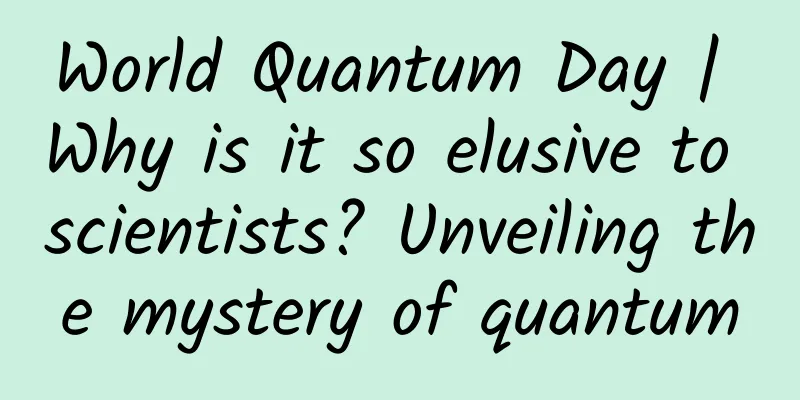World Quantum Day | Why is it so elusive to scientists? Unveiling the mystery of quantum

|
|||| Compiled by New Media Editor Duan Dawei April 14th is World Quantum Day. The reason why World Quantum Day was chosen on April 14th is because Planck's constant is 4.135667696×10-15eV·s, which is approximately 4.14, although this number has now been revised to another long string of numbers that is more accurate. If using international units, Planck's constant is 6.62607015×10-34J·s. It is an initiative launched by scientists from more than 65 countries in 2021 to designate April 14th of each year as "World Quantum Day" in order to stimulate people's interest and enthusiasm in quantum technology and to raise public awareness of the positive impact that quantum science has and will have on society. It is an international event focusing on quantum technology. What is quantum? How has it changed us? What is the current status of quantum technology in my country? ◈ ◈ ◈ The "mysterious" quantum world To understand quantum technology, we must first talk about quantum. What is quantum? According to quantum theory, quantum is the most basic unit of matter and the most basic carrier of energy, and it is indivisible. If a thing has the smallest indivisible basic unit, we can say that it is quantized and call the smallest unit a quantum. All the microscopic particles that people are familiar with, such as molecules, atoms, electrons, photons, etc., are a form of quantum manifestation. Cao Zexian, a researcher at the Institute of Physics of the Chinese Academy of Sciences, once made such an analogy in his 2020 New Year's Eve Science Speech that the smallest units of things we can see and perceive in our lives, including light and energy, can be called quanta. Just like when we look at a school of fish from a distance, it looks like a dark mass, but when we zoom in, we see individual fish, which can be said to be the quantum of the school of fish. In the view of Yuan Lanfeng, associate researcher and science popularization expert at the University of Science and Technology of China, the original meaning of quantum is a mathematical concept, which in simple terms is "the smallest unit of discrete change." What is "discrete change"? Yuan Lanfeng explained it this way: When we count the number of people, we can have one person or two people, but we cannot have half a person or 1/3 of a person. When we climb stairs, we can only climb one step or two steps, but not half a step or 1/3 of a step. These are "discrete changes". For counting people, one person is a quantum. For climbing stairs, one step is a quantum. If something can only change discretely, we say it is "quantized". Different from the macroscopic world we know, people have found that many experimental phenomena in the microscopic world of quantum go against common sense and cannot be explained by classical physics at all. For example, according to classical physics, the state of an object (represented by 0 and 1) is like the simplest binary on and off, and can only be in one of the states of on or off, that is, either 0 or 1. This is like a cat, which is either alive or dead, and cannot be "alive and dead" at the same time. But this theory does not apply to the quantum world: in the quantum world, a cat can be in a superposition of life and death. This so-called quantum coherence superposition is the fundamental difference between the quantum world and the classical world. What’s even more amazing is that this superposition state is extremely fragile. Once someone measures it, it will immediately change from a superposition state to a definite state. To understand this, imagine you have a particle and two detectors, one on the left and one on the right. If you send the particle to the left, the left detector will tick. If you send the particle to the right, the right detector will click. But in quantum mechanics, you can do more than that: you can have a particle in two states at once. For example, you can send a particle through a beam-splitter so that it can then move both to the left and to the right. Physicists say the particle is in a "superposition" of left and right. American physicist and Nobel Prize winner Murray Gell-Mann once lamented that quantum mechanics is a mysterious and elusive subject. None of us can truly understand it, but we only know how to use it. ◈ ◈ ◈ Quantum technology for change Although quantum seems mysterious, quantum technology is actually not that far away from people. Quantum technology has brought rich technologies and applications, and has profoundly changed human civilization and history. Quantum technology provides the hardware foundation for the information revolution. The principles of lasers, semiconductor transistors, and chips all originate from quantum mechanics. Quantum mechanics also makes new technologies such as information storage on disks and optical disks, light-emitting diodes, and satellite positioning and navigation possible. Without quantum mechanics, the Internet and smartphones would not exist. Quantum technology also provides analytical tools for materials science and technology, medicine and biology, including x-rays, electron microscopes, positron annihilation, optical and magnetic resonance imaging, etc. So, quantum is our old friend. In fact, in the 1990s, Nobel Prize winner Lederman pointed out that quantum mechanics contributed one-third of the US GDP at that time. The proportion is much higher now, and it is difficult to find new technologies that are not related to quantum. It can be seen that quantum mechanics is an important foundation of contemporary civilization. These more traditional scientific and technological achievements are based on quantum mechanics and have developed to a relatively mature stage. Today, the development of quantum technology has great scientific significance and strategic value, and will lead the direction of a new round of scientific and technological revolution and industrial transformation. By more accurately designing and manipulating these characteristics of quantum states, people expect to achieve major disruptive technological innovations in the second quantum technology revolution that will impact and reconstruct traditional technological systems. Representative areas include quantum computing, quantum communications, and quantum precision measurement. It can be said that the realization of precise control of quantum states will promote the development of human productivity no less than the invention of steam engines, generators, and semiconductor transistors. Facing the upcoming second quantum technology revolution, on the one hand, we look forward to the surprises it will bring, and on the other hand, we must also be fully prepared to seize this development opportunity. As Academician Xue Qikun of the Chinese Academy of Sciences said, "Scientists are opening up new frontiers in the field of quantum science, and if quantum technology is to truly bring benefits to mankind, it requires the participation of more innovative entrepreneurs, entrepreneurs, investors, etc." ◈ ◈ ◈ China's quantum technology advances into the "first camp" Guo Guangcan, an academician of the Chinese Academy of Sciences and director of the Key Laboratory of Quantum Information of the Chinese Academy of Sciences, said, "In the three major fields of quantum, we are now in the first echelon in all aspects. Quantum computing used to be relatively backward, but now it is gradually catching up." Quantum computing has "unlimited potential" The birth and development of quantum mechanics has provided new possibilities for "computing". As scientists' understanding of the basic principles of quantum mechanics continues to deepen, people have discovered that some basic properties of quantum mechanics, such as superposition and entanglement, can greatly improve the encoding and processing capabilities of information. A well-designed "quantum algorithm" can bring significant computing acceleration capabilities. On December 21 last year, the American Physical Society's Physics website announced ten major advances in the field of international physics in 2021. The "Zu Chongzhi-2" and "Jiuzhang-2" quantum computing superiority experiments completed by Pan Jianwei, Zhu Xiaobo, Lu Chaoyang and others from the University of Science and Technology of China were selected. This makes my country the only country in the world that has reached the "quantum computing superiority" milestone in both physical systems at the same time. (Photo source: Anhui.cn) ▲The overall installation diagram of "Jiuzhang No. 2". (Photo source: University of Science and Technology of China) "Quantum supremacy" is like a threshold. It means that when the computing power of a new quantum computing prototype exceeds that of the most powerful traditional computer on a certain problem, it proves that it has the potential to surpass others in many aspects in the future. Last October, Jiuzhang-2 solved Gaussian boson sampling 10 to the 24th power times faster than the world's fastest supercomputer; Zuchongzhi-2's computational complexity was 1 million times higher than Google's Platanus. my country's "quantum superiority" is eye-catching. "Now we can say that our quantum computing has also entered the world's first echelon." "Jiuzhang-2" and "Zu Chongzhi-2" were developed by the team of Academician Pan Jianwei of the University of Science and Technology of China, said Lu Chaoyang, a team member and project leader of "Jiuzhang-2". “Secure and reliable” quantum communication Recently, the Beijing Institute of Quantum Information Science, the teams of Professor Long Guilu and Professor Lu Jianhua from Tsinghua University have collaborated to design and implement a new quantum direct communication system that uses a mixed encoding of phase quantum states and timestamp quantum states. The communication distance reaches 100 kilometers, which is currently the longest quantum direct communication distance in the world. ▲Schematic diagram of the principle of the new quantum direct communication system (Photo source: Beijing Science and Technology News) Traditional communication methods are based on encryption algorithms or encryption technologies. If the computing power is strong enough and the encryption algorithm is cracked, there is a risk of being eavesdropped. The unique characteristics of quantum give it "innate advantages" such as non-cloning and uncertainty. Using quantum "keys" to transmit information, the encrypted content cannot be deciphered, and eavesdroppers will inevitably be "caught", so that eavesdroppers cannot obtain signals, thereby ensuring that the transmitted information cannot be deciphered by calculation in principle, and therefore has absolute security. “Data-accurate” quantum measurement On November 13, 2018, the 26th General Conference on Weights and Measures redefined the four basic units of kilogram, ampere, kelvin and mole, corresponding to four basic constants: Planck constant, basic charge, Boltzmann constant and Avogadro constant. After the vote, it was officially implemented on May 20, 2019, "World Metrology Day". The redefinition of the international system of units marks the arrival of the quantum era of the international system of units and precision measurement, which has far-reaching influence and great significance. In short, quantum metrology is based on time and frequency units, with basic physical constants as the medium, to achieve the reproduction of basic units or derived units. In order to unify international measurement units and improve measurement accuracy, the General Conference on Weights and Measures redefined the seven basic physical units in a quantized form. After these constants are uniformly defined, the units of physical quantities can be reproduced anywhere in the world, and no longer need to be traced back to the physical benchmark of the International Bureau of Weights and Measures, truly achieving the goal of "quantization of measurement units and flattening of value traceability". ▲Quantization definition of the seven international basic units (Photo source: Xinhuanet) After physical units are quantized, the measurement accuracy can be significantly improved. Taking the time unit "second" and the frequency unit "Hertz" as examples, after quantization, their accuracy has increased from one millionth to one trillionth, and the uncertainty of the optical clock frequency has even been as low as one trillionth. These achievements have promoted the great development of satellite navigation, computers, and the Internet. In addition, after the length unit "meter" is quantized, the measurement error has rapidly increased from 0.1 microns (one ten-thousandth of a millimeter) to thousands of times, which has promoted the improvement of aerospace technologies such as fighter jets. In the field of quantum precision measurement, China's scientific research level and technological application are on par with those of European and American countries, and each has its own advantages. In recent years, my country has achieved major achievements such as single-photon Kerr effect measurement with Heisenberg limit precision, 200-kilometer single-photon three-dimensional imaging, and detection of magnetic resonance spectra of single DNA molecules in room temperature aqueous solution environment. In addition, China has developed innovative products such as quantum diamond single spin spectrometer and quantum diamond atomic force microscope based on the diamond NV color center technology route. While quantum technology is developing rapidly, its development and application prospects are still long-term and uncertain. Dr. Lai Junsen from the Institute of Technology and Standards of the China Academy of Information and Communications Technology introduced that, taking quantum computing as an example, the threshold of error-correctable logical quantum bits has not yet been crossed, large-scale general quantum computing is still a long-term goal, and the quantum computing system architecture and software system are still in the initial exploration stage. The requirements for the working environment are still very strict. Superconducting, photon, ion trap, semiconductor, topology and other technical routes are developing in parallel, and it is still unknown which route will "win" in the future. Therefore, the future of quantum technology is bright but it is by no means a smooth road. Only by not fearing difficulties and obstacles can we reach a new "quantum peak" and build new advantages. (Source: "Institute of Physics, Chinese Academy of Sciences", "Principle" WeChat public account, Xinhuanet, People's Daily, Beijing Science and Technology News, etc.) Produced by: Science Central Kitchen Produced by: Beijing Science and Technology News | Beijing Science and Technology Media Welcome to share to your circle of friends Reproduction without authorization is prohibited |
<<: Artificial Intelligence, in a Jar
Recommend
Meituan takeaway channel operation skills!
When the mini program was not yet launched, and w...
5 steps and 5 rules for copywriting!
Article Summary: ● Five steps in copywriting (cla...
12 ways to activate your social network
Many communities die soon after they are establis...
User Growth Primer
The term " user growth " has become ver...
Is it really dangerous to be a vegetarian? It’s a “technical job”! Do these things to stay safe →
Ever since Liu Xiaoqing mentioned that her friend...
Will free traffic service become the next “free lunch”?
Earlier this year, Dan Check, vice president of t...
Analysis of 7 short video channels including Taobao and Video Account!
Douyin, Kuaishou, Xiaohongshu, Taobao, Video Acco...
Three departments jointly issued a notice to strengthen the management of in-vehicle audio and video, and network services need to obtain a license
Recently, the Ministry of Industry and Informatio...
I think this is a good way for Alipay to do it!
Our classmates at Alibaba have always had a hat o...
Price inquiry for customized mini program of Bozhou Driving School. How much is the price for customized mini program of Bozhou Driving School?
The mini program provides convenience for publici...
These 100 classic copywriting sentences can instantly catch your eye and make you feel excited.
Good copywriting can instantly catch the eye, gri...
The ancient staple food is sharing its "growth diary"! How many members of the rice family do you know?
An ancient staple food with a long history The ri...
How does the Himalayan wind light up the lights of the Qinghai-Tibet Plateau?
On August 3, my country's highest-altitude wi...
Take a sneak peek at the majestic figure of “Kuafu” and look forward to the feat of “chasing the sun” in the future!
The sun is the source of life and the symbol of l...
Changan Automobile's All-Area All-Scenario Power Solution and New Blue Whale Power Release Conference
On March 13, Changan Automobile officially launch...









